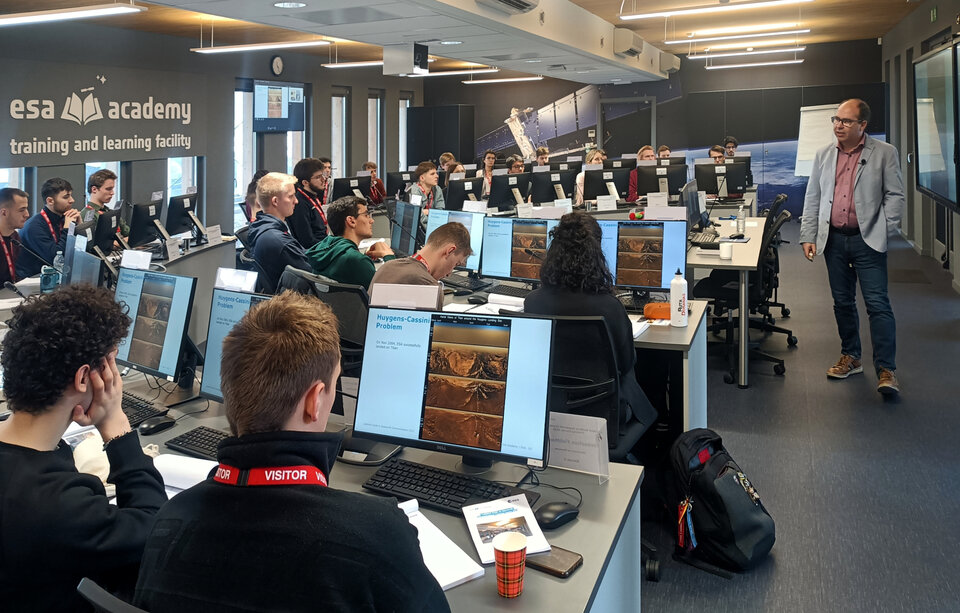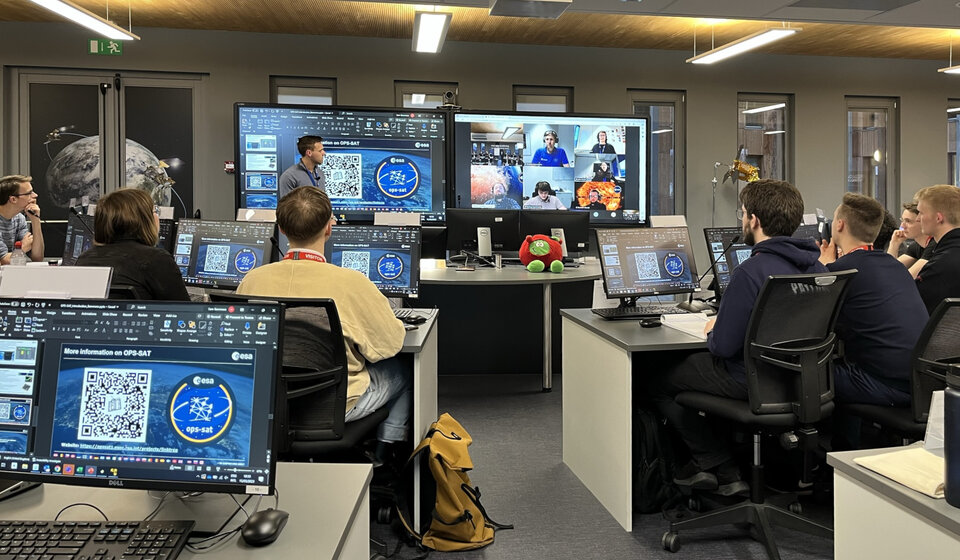A new look for the Ladybird Guide to Spacecraft Communications Training Course
Last February 30 Bachelor, Master and PhD students from 16 different ESA Member and Associate States successfully completed ESA Academy’s Ladybird Guide to Spacecraft Communications Training Course. In a brand-new format, the first 4 days were hosted at the European Space Security and Education Centre (ESEC) in Belgium as always, but an extra final day took place at ESA’s European Space Operations Centre (ESOC) in Germany.

The 7th edition of the Ladybird Guide to Spacecraft Communications Training Course took place from 13 to 17 February. After some days at ESA Academy’s Training and Learning Centre in ESEC, students had the incredible opportunity to visit ESA’s establishment ESOC in Germany, an internationally recognised centre of excellence for space debris studies and services, ground system engineering, the design and development of tracking stations, and satellite navigation, thus adding unquestionable value to our students’ experience.
The course, delivered by a senior ESA engineer from the Operations Department of ESOC, taught students the fundamental concepts of spacecraft communications in a “Ladybird Guide” style, without complex mathematical details. The trainer used plenty of real examples of challenging situations he has had to face during his extensive career, bringing the course to life for the students.
Content was split into six key spacecraft communications topics:
- Signal modulation and demodulation
- Channel coding
- Communication protocols
- Transmission
- Signal reception
- An overview of some real ground stations
“I've never learned so many things in only a week, the course is a complete and quite detailed overview of what being a Spacecraft Operation Engineer means,” explained an Italian student from La Sapienza University of Rome. “I really appreciated the approach of the trainer: stick to the problem, don't panic, analyze the possible solutions, prioritize things, try the most appropriate strategy.”

To illustrate the lectures, the students also had the opportunity to join the OPS-SAT Operations Team for a “live-pass” where they each got the chance to remotely send commands to the OPS-SAT satellite as it passed over the ground station! In addition, they visited ESEC-Redu with two satellite and ground station engineers to learn about the PROBA and GALILEO satellite programmes and how engineers at the site communicate with these spacecraft. Highlights included a tour of the PROBA Operations Room and the inside of the Redu 1 Antenna, which boasts a 15-metre diameter dish.
The importance of this philosophy became clear to the students when they were challenged to put their new knowledge into practice in a simulated communications scenario. During the week, they worked through several group exercise sessions to design a communication system for a fictional mission, and on the final day they had the incredible opportunity to use the headsets and systems in the Mission Control Room at ESOC to operate their spacecraft and try to communicate with it as it underwent a simulated anomaly. It was a challenging task for the students, but two of the three teams were able to successfully recover their spacecraft in time.
“Sitting in the Mission Control Room, feeling the tension and frustration, the time ticking away while we tried to recover our mission, and then the final sensation of pure joy when the telemetry came, all of this was priceless. After the simulation was over I can remember me, as I believe everyone on my team, just craving to do it over and over again,” described a student from Politecnico di Milano. “Easily one of the best experiences you can have as a student.”
In addition to the final group exercise session, the students enjoyed a tour of ESOC and short presentations from engineers who are involved in space mission design and operations in different roles, for example Mission Analysis and Flight Dynamics.
“I am leaving this training with lots of new information that was explained in order to be easily understand by everyone,” concluded a Romanian student from Politehnica University of Bucharest. “Not only the trainings, visits and the simulation were great, but also the people that I met during the week, all having the urge to know more about the space sector. The future looks bright and I am hoping to work with such passionate people in the future!”

To find more information about upcoming ESA Academy training opportunities, please visit: http://www.esa.int/Education/ESA_Academy/Current_opportunities
Contact: tlp@esa.int















 Germany
Germany
 Austria
Austria
 Belgium
Belgium
 Denmark
Denmark
 Spain
Spain
 Estonia
Estonia
 Finland
Finland
 France
France
 Greece
Greece
 Hungary
Hungary
 Ireland
Ireland
 Italy
Italy
 Luxembourg
Luxembourg
 Norway
Norway
 The Netherlands
The Netherlands
 Poland
Poland
 Portugal
Portugal
 Czechia
Czechia
 Romania
Romania
 United Kingdom
United Kingdom
 Slovenia
Slovenia
 Sweden
Sweden
 Switzerland
Switzerland

























